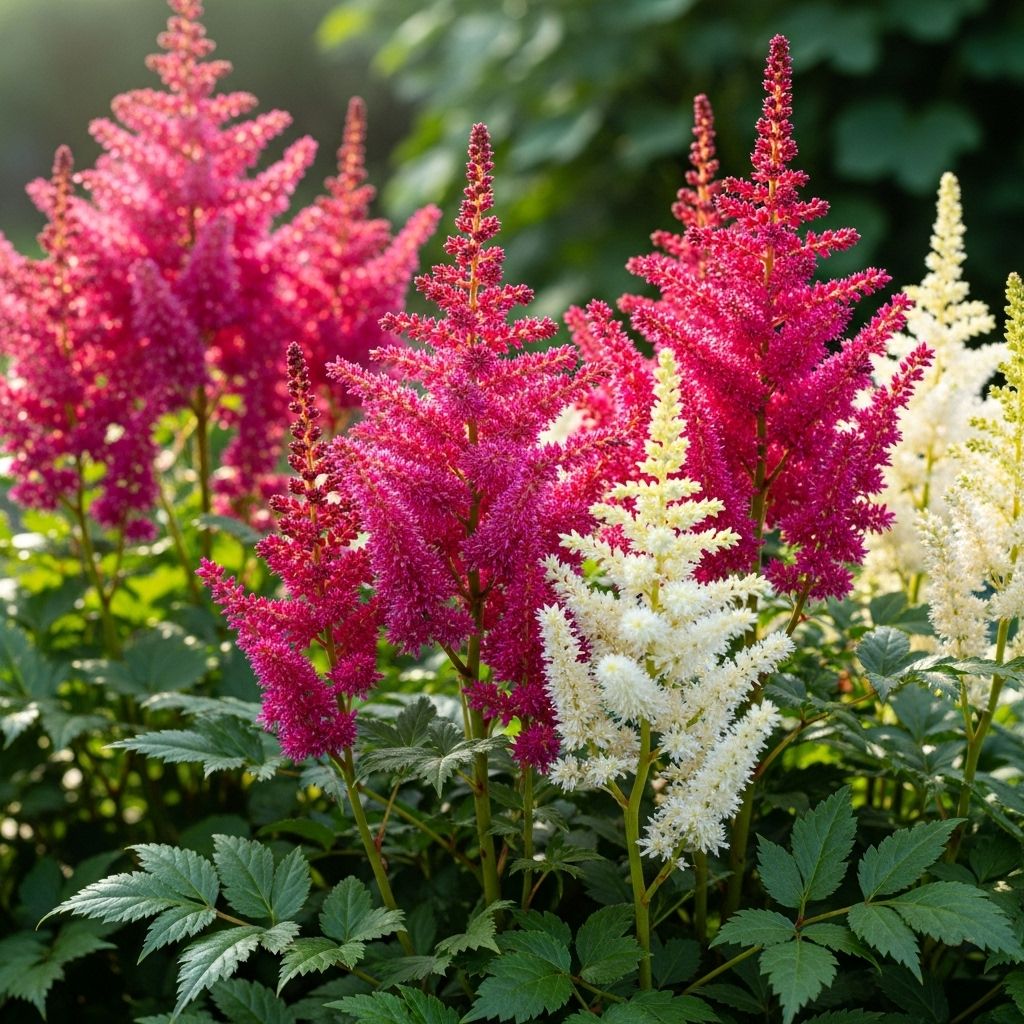Astilbe (False Spirea): The Ultimate Perennial Plant Care Guide
Rich soil and steady moisture unlock vibrant floral plumes in woodland beds.

Image: HearthJunction Design Team
Astilbe, also known as false spirea, is a beloved perennial prized for its fern-like foliage and feathery plumes of flowers that brighten shaded corners of the garden. Its shade tolerance, elegant structure, and low-maintenance requirements make it a favorite for both novice and experienced gardeners.
Introduction to Astilbe
Astilbe, sometimes called False Spirea, is one of the most dependable and ornamental perennials. Loved for its ability to thrive in shade and moist conditions, astilbe adds beautiful color and texture from early spring to late summer. With their fluffy, plume-like flower heads, these plants provide lasting appeal in gardens and bouquets alike.
- Botanical Name: Astilbe spp.
- Common Names: Astilbe, False spirea
- Family: Saxifragaceae
- Plant Type: Herbaceous perennial
- USDA Hardiness Zones: 3–9
Key Features of Astilbe
- Shade-loving perennial with fern-like foliage
- Showy, airy plumes of pink, red, lavender, white, or purple flowers
- Deer-resistant and suitable for woodland gardens
- Blooms from late spring through midsummer depending on the variety
Where to Plant Astilbe
Astilbes thrive in areas that receive partial to full shade. While some newer varieties can tolerate more sun, all types require consistently moist, rich, well-drained soil to perform their best. The best spots are those where the soil never dries out and afternoon shade is available.
- Ideal for woodland gardens, the edges of ponds, or north-facing beds
- Plant with other shade-loving species such as ferns, hosta, or woodland perennials
- Avoid planting in sites with poor drainage or heavy clay that holds water
Light Requirements
- Part Shade to Shade: Astilbe thrives in dappled light, morning sun with afternoon shade, or full shade.
- Full Sun: Only suitable if soil is kept constantly moist.
Soil Preferences
- Needs rich, humus-laden, well-drained soil
- Consistent moisture is crucial; drought will cause leaf edges to brown
- Incorporate compost or well-rotted manure before planting
How to Plant and Propagate Astilbe
Timing
- Plant astilbe in early spring or fall, when temperatures are cool and rain is plentiful
Planting Steps
- Prepare the soil: Enrich the garden bed with compost or organic material. Loosen the ground for good drainage and root penetration.
- Dig the hole: The hole should be deep enough to allow roots to spread, with the crown (where roots meet the stem) level with or just above the soil surface.
- Place the plant: Gently spread out the roots and backfill with soil, pressing firmly to eliminate air pockets.
- Water well: Water deeply immediately after planting, and keep the soil consistently moist while the plant establishes itself.
Spacing
- Allow 18–24 inches between plants for mature growth.
Propagation
- Astilbe is readily divided every three to four years in early spring or fall
- Use a sharp spade or knife to separate the clump into several pieces, each with roots and growing points (“eyes”)
- Replant divisions immediately in prepared soil
Caring for Astilbe
Watering
- Keep soil consistently moist: Water regularly and deeply, especially in dry spells or hot weather
- Avoid waterlogging: Good drainage is essential; mulching helps retain moisture and reduces watering frequency
Mulching
- Apply organic mulch (e.g., leaf mold, wood chips, compost), keeping it away from the crown
- Mulch helps keep soil cool and moist, and adds slow-release nutrients as it decomposes
Fertilizing
- Astilbe are heavy feeders—apply a balanced, all-purpose or slow-release organic fertilizer in early spring before flowering
- For early-flowering varieties, a second application of high-nitrogen fertilizer in the fall encourages future blooms
Pruning and Maintenance
- No deadheading required: Spent flower plumes may be left for winter interest or removed for a tidier appearance
- Cut back old foliage in late winter or early spring, before new shoots emerge
- Dividing: Divide crowded clumps every three to four years to maintain vigor
Common Problems and Solutions
| Problem | Cause | Solution |
|---|---|---|
| Leaf edges browning | Drought stress or too much sun | Provide regular water, move to shadier location if necessary |
| Rotting flowers or stems | Waterlogged or poorly draining soil | Improve drainage, avoid overwatering |
| Poor or no blooming | Plant too young; lack of nutrients; too much shade | Patience, fertilize, consider increasing light |
| Powdery mildew | Humid, overcrowded conditions | Increase air circulation, thin out clumps |
| Insect pests: Japanese beetles, rabbits | Occasionally feed on foliage | Remove beetles by hand, use fencing for rabbits |
Best Astilbe Varieties
- Astilbe chinensis: Tolerates some drought; flowers late summer; colors range from pink to purple
- Astilbe japonica: Early-blooming with red or pink feathery spikes
- Astilbe arendsii: The most hybridized group—offers a wide color range and robust habit
- Astilbe simplicifolia: Known for delicate, fine texture and small stature—great for edging
Companion Plants: What Grows Well with Astilbe?
Astilbe blends beautifully with other shade or woodland plants. Good companions include:
- Hosta – broad-leaved contrast pairs elegantly with feathery astilbe foliage
- Ferns – reinforce the lush, woodland effect
- Heuchera (coral bells) and Brunnera for vibrant foliage color
- Japanese forest grass and solomon’s seal
- Shade-tolerant bulbs such as snowdrops or woodland anemones
Design Ideas for Astilbe in the Garden
- Plant in groups for the most dramatic color impact
- Interplant with early and late bloomers to extend the season of interest
- Use along woodland paths or near water features for a naturalistic look
- Add to cut flower arrangements for lasting texture and color
- Allow spent plumes to remain for winter interest and wildlife habitat
Frequently Asked Questions (FAQs)
Q: Are astilbes difficult to grow?
A: No, astilbes are low-maintenance as long as they receive adequate moisture and partial shade. They are tough perennials with few disease or pest issues.
Q: How long does it take astilbe to bloom after planting?
A: Astilbes planted as bare roots or young plants may take a season or two before they flower profusely.
Q: Do astilbe need deadheading?
A: No. Deadheading is not required, but removing spent flowers can tidy up the look. The seed heads also add winter interest.
Q: Are astilbe deer-resistant?
A: Yes, astilbe is generally considered deer-resistant and is a good choice for gardens where deer browsing is a problem.
Q: Can astilbe grow in full sun?
A: Only if the soil remains cool and moist. Without consistent water, astilbes will not thrive in full sun and leaves may scorch.
Q: Why is my astilbe not thriving?
A: Most often, the culprit is lack of water or poor soil conditions. Also consider sunlight exposure and whether regular fertilizer is being applied.
Final Thoughts
With their reliable blooms, striking foliage, and minimal maintenance, astilbes are a wise and rewarding investment for any shade garden. By providing moist, rich soil and periodic division, gardeners can enjoy abundant feathery plumes in their outdoor spaces for years to come.
References
Read full bio of Anjali Sayee












